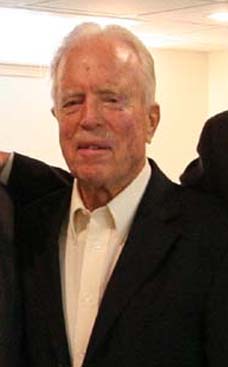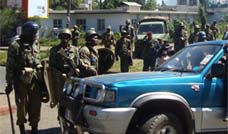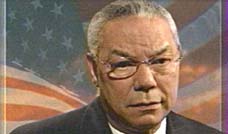
It wasn’t my intent to begin a photography career in the little town of Elías Piña on the Dominican Republic side of the Caribbean island of Hispaniola, but that is what happened. Sometimes life gives you the time to immerse yourself in something you might otherwise have passed by. My interest in photography grew out of culture shock caused by living in a poor town on the Haitian border. Dominicans called it “The Frontier.” It had been largely off-limits to Dominicans throughout the three decades of rule by Dictator Rafael Leonidas Trujillo. Life there was so different, so basic and so life-and-death; I felt I had to photograph it. It was a subject-rich environment. Everywhere I turned, there were compelling pictures to be taken.
John Terence Turner got his start in Photography as a Peace Corps Volunteer in the Dominican Republic
Real Life . . .
By John Terence Turner
Stock Asylum Columnist
Dec. 3, 2007
© 2007 John Terence Turner
Caption: Fuera Yanquis means“out Yankees." Turner says he is seen here weighing less than at any time since. The photo was made using a Nikkor 35mm f2 lens on a Nikon F body. ( © John Terence Turner ).
“For strange effects and extraordinary combinations we must go to life itself, which is always far more daring than any effort of the imagination.” –– Sir Arthur Conan Doyle, The Red Headed League
Some things in life start without a plan. Circumstances converge, time is available and the first thing you know, a career is begun.
It wasn’t my intent to begin a photography career in the little town of Elías Piña on the Dominican Republic side of the Caribbean island of Hispaniola, but that is what happened.
Sometimes life gives you the time to immerse yourself in something you might otherwise have passed by.
My interest in photography grew out of culture shock caused by living in a poor town on the Haitian border.
Dominicans called it “The Frontier.” It had been largely off-limits to Dominicans throughout the three decades of rule by Dictator Rafael Leonidas Trujillo.
Life there was so different, so basic and so life-and-death; I felt I had to photograph it.
It was a subject-rich environment. Everywhere I turned, there were compelling pictures to be taken.
I had brought a Nikon F and four lenses, 55mm f1.2, a 35mm f2, a 135mm f2.8 and a 200-600mm f8 (this last one was not only a big lens, it was a big mistake!).
I was rarely without my camera and a little bag of black and white film. The camera and two or three lenses fit into a small rucksack that I could carry on my motorcycle.
My work was in tuberculosis control and community development. The latter comprised helping with a yearlong series of events to raise money for an X-ray machine for the local hospital, providing services to a small housing project outside town, working with a local Boy Scout troop, and teaching English to some local teachers.
he town was isolated and quiet.
There was a movie theatre that showed films two nights a week and a TV set in the town square that offered no news but endless re-runs of Combate! and Stalag 17.
Electricity was not dependable, but since the only streetlights were in the middle of town, it was sometimes hard to tell if power was off.
There was a restaurant-bar mainly patronized by Army officers from the local Fortaleza. They were supposed to repel the improbable invasion from Haiti.
Hanging out with the Army would have been harmful to my community development work. The Army represented the power structure that community development was supposed to counter.
Accordingly, I spent most of my nights reading and listening to the BBC. I began to request photography books from my parents and devoured them as soon as they arrived.
A recruiting brochure about the Teacher Training Program I had photographed and partly written was received enthusiastically in Washington, D.C.
I was transferred to Santo Domingo so I could photograph more such projects.
By that time, I had been in the country for a year-and-a-half so my Spanish was good and was fairly comfortable with the culture.
Because of the brochure and other pictures I had been getting published in the international Peace Corps magazine, I approached the Director of the US Information Agency at its office across the square from the Catedral Primada de America (first cathedral in the Americas).
I informed him that I was the Peace Corps photographer for the DR –– a title I had just awarded myself. I asked if I could get film processed in their lab.
“Of course,” he said, “but you’ll have to do it yourself and only after we close at 6 p.m. — we’ll give you a key.” He added that I could use all the photographic supplies I wanted because the departing U.S. military had left “tons” when they had departed after the civil war.
This column is about one unusual night that revolved around my use of the lab and events during one night in the Zona Colonial.
In 1965, the Dominican Republic had a civil war in which Lyndon Johnson, erroneously citing “52 known Communists” as part of the anti-military side of the conflict, sent US troops to aid the generals and settle the civil war in favor of the military junta.
For a brief time in 1965, the US had more troops in the Dominican Republic than in Vietnam. That changed within the year.
Santo Domingo is the oldest European city in the new world (founded in 1496).
Not surprisingly, the streets in the Zona Colonial are narrow, they are not straight and buildings sometimes protrude out over the sidewalks.
Nonetheless, it is somewhat charming with occasional surprisingly pleasant buildings with wrought-iron balconies hung with plants that suggest elegant interiors.
The Cathedral, the USIA office and the Hotel Colón were all in the Zona Colonial, the original Santo Domingo, which dates back to the early 1500s and is bordered by the River Ozama and Bay of Santo Domingo.
The Zona Colonial had been the headquarters of the rebels during the civil war that ended just a year before our group arrived in country.
While Americans were generally welcomed in the countryside, the Zona was a different matter; there was still a lot of anti-Americanism evident in graffiti on walls, and curses shouted from passing cars.
The square in front of the Cathedral was at one corner of the Zona and the Alcazar de Colón (where Christopher Columbus’ son Diego was the vice-regent of the Americas in 1517) was at another.
Late one night, I had been making prints in the USIA lab on the square by the Cathedral (where some of the bones of Columbus are said to be buried).
That day I had shot the picture of the boys rolling hoops. It was one of my first action shots and I liked it. I wanted to make some prints so I show them around.
I also had just shot the portraits of the two old women that I like because they are in completely different lighting situations. To make the picture of the man plowing a rice paddy, I had jumped off my motorcycle and captured the image with my 135mm telephoto.
I realized that I had left some negatives back at hotel Colón ( It was a seedy hotel used by Peace Corps to house Volunteers in the capitol on official business. The name of the hotel caused innumerable jokes by volunteers with afflicted with dysentery), so I returned to get them.
On my way back, I turned onto Avenida Isabella la Catolica (Queen Isabel, who paid for Columbus’ trip to the New World), when I noticed four drunken men on the other side of the street headed the same direction I was.
It was almost midnight. I didn’t pay a lot of attention to the four drunks, who looked to be in their 20s.
In this part of town, being inconspicuous was the best way for an American to be.
Apparently I wasn’t inconspicuous enough. A rum bottle exploded on the stone wall just to my left—showering me with glass shards.
“Hijos de la gran puta!” (SOBs) I yelled, and more –– including more specific references to their mothers.
They replied in kind. I sped up, and then they sped up. We were paralleling each other down the dark, narrow street.
They didn’t want to throw their remaining bottle before it was empty, so they were passing it back and forth. They matched my increasingly nervous pace as I calculated my chances.
As long as this arrangement continued, I’d be OK, I thought, it’s only three more blocks to the square and once there, I can get into the lab and be safe.
Then one of them split from the group and began walking faster as if he was going to get ahead of me and cut me off. If he did, I’d be trapped with one in front and three behind.
We were approaching a fork in the street. To street to the right was even narrower and there seemed to be lots of shops with dwellings above, each with balconies that extended out over the sidewalk. My route back to the lab required that I stay to the left.
I noticed that there was a pile of construction debris that spilled off the sidewalk on my side and into the street. I also noticed the guy had got farther ahead of me on the other side. It appeared that he was about to cross over to my side and cut me off from the lab.
Meanwhile, his pals were working on their bottle of rum and simultaneously urging him to “get the yanqi.”
He began to cross the street just as I got to the pile of debris. I stooped and picked up a piece of broken concrete about the size of a grapefruit.
By this time the two of us were a block ahead of the other three. The guy in front came across the street on the other side of a telephone pole, not ten feet ahead of me.
I had the concrete in my right hand; I raised it and faked a move to my right, as if I was going after him around that side of the telephone pole. He fell for the fake and came toward me on my left, with his head down, diving for my midsection.
I was already swinging at him with my right. I hit him on the side of his head with the concrete –– hard. He fell, but in the process, he made a sloppy tackle and lost his momentum. Instead of falling on my back with him on top of me, I fell on my side and quickly scrambled onto his chest and started beating him in the face with my fists.
At this point, I must add that I am not big, nor was I then. I’d had dysentery five times during the preceding 18 months and I weighed about 135 pounds.
But fear and adrenalin produced desperate violence.
I knew I had only a few seconds to pound my assailant and get out of there before the other three arrived.
At that moment, a faded, government-green International (Dominicans called them “gwa-gwas” (they were like Suburbans) pulled up to the curb. The street was so narrow it was almost on top of us on the sidewalk.
In it were two Peace Corps officials, a man and a woman. The man was the Deputy Director and he leaped out of the International and yanked me by the shoulders, pulling me off what he had decided was my innocent Dominican victim.
“Turner, what the hell are you doing?” he yelled, obviously concluding that I was wrongly assaulting an HCN (Host Country National).
Before I could answer, we heard a loud crack, followed by a shriek from the female Peace Corps official in the front seat.
They hadn’t seen the other three drunks and one of them had sneaked up to the International and threw his glass at her head as she sat in the front seat.
Fortunately, he missed her, but the heavy-bottomed bar glass hit the inside of the windshield and cracked it.
Once again, before any of us could do anything, a Dominican Army jeep roared up, the soldiers leapt out and the officer deployed a Prohibition-era Thompson sub-machine gun and emptied the long clip of .45 caliber ammo at the drunks fleeing down the right-hand fork in the street.
There was no evidence that he hit anyone.
The long burst of machine gun fire stopped and the empty brass cartridges tinkled around the lieutenant’s feet on the cobblestones.
The smoke wreathed the face of the young officer and he smiled proudly at the Americans he believed he had saved.
At this point in my narrative I wish that I could say that he had grinned at us and said, “I love the smell of gunpowder at midnight.” But Apocalypse Now hadn’t been made yet.
I think he just asked us if we were OK and told us to get out of the neighborhood.
I picked up my little envelope of negatives and hastened to the lab.
Once there, I found that I was too wound up for a quiet session in the darkroom. I put away the things I’d been working on and went back to the Hotel Colón.
A Volunteer from New York named Vince Fay was there and I told him of my adventure on the street.
He commiserated and offered to buy me a drink at a nearby bar.
We headed for the bar, downed a couple of rums and I disinfected the cuts on my knuckles.
Out front was a 55-gallon oil drum with a fire in it. Several publico drivers were warming their hands by the flames and grilling little pieces of meat.
Vince suggested we go out to a little resort called Boca Chica, sleep on the beach, have a morning swim and then come back into the city.
We persuaded one of the publico drivers to give us a cheap ride. The Santo Domingo airport was near Boca Chica and he wanted to be at the airport to pick up fares when the first international flights came in.
We sneaked onto the beach by going through an outdoor bar that was closed for the night. The air and sand were warm so we were able to sleep with rolled-up sweatshirts as pillows.
In the morning we had a refreshing swim in the crystal-clear water and caught another ride back to the capitol.
The Peace Corps headquarters was in an old mansion on Avenida Bolívar.
When I arrived, with salt in my hair from the swim and cut knuckles from the fight, I was told sternly, “The Director wants to see you.”
As I expected, I was being blamed for the broken windshield on the International, and for fighting with Host Country Nationals.
It took some doing, but I was able to explain what happened to the grudging satisfaction of the Director. His name was Caleb Roehrig, he was a former Polaroid executive who seemed to view me as a useful volunteer.
He recognized that I could contribute to the Peace Corps with my photography. The essays I was shooting about programs in the country reflected well on his administration.
I was happy with the arrangement, I just didn’t expect to have to fight my way to the lab to make prints of the pictures I was taking.
(John Terence Turner has been shooting stock photography for 20 years. His work can be seen at Getty Images, Alamy and, of course, The Stock Asylum, where his column appears twice a month. He lives and works in Seattle, WA.)









